Introduction
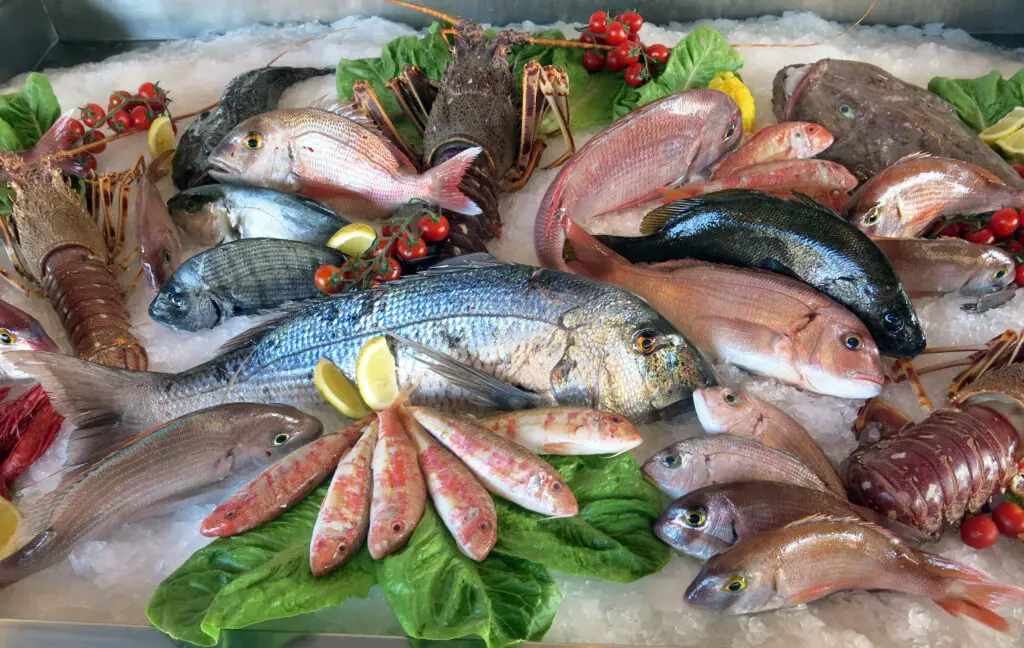
Choosing the right fish for your next culinary adventure can be an exciting and rewarding experience. Whether you are entertaining guests or preparing a meal for your family, seafood offers a wide range of options to suit various tastes and preferences. Additionally, it caters to both non-vegetarian and vegetarian individuals, making it a versatile ingredient. By considering a few key factors, such as sustainability, freshness, and flavour, you can ensure that you serve a delightful seafood dish that will leave everyone craving for more.
Sustainability: A Responsible Choice
When selecting fish, it is crucial to consider sustainability to help protect our oceans and ensure future availability of seafood. Look for varieties that are labeled as sustainable or that have been certified by reputable organizations like the Marine Stewardship Council (MSC). These organizations assess the environmental impact of different fishing methods and provide guidelines for responsible fishing practices. By choosing sustainable fish, you are contributing to the preservation of marine ecosystems.
Types of Sustainable Fish
There is a wide range of sustainable fish options available. Some popular choices include:
- Alaskan salmon
- Atlantic mackerel
- Arctic char
- Pacific sardines
- Rainbow trout
The Freshness Factor
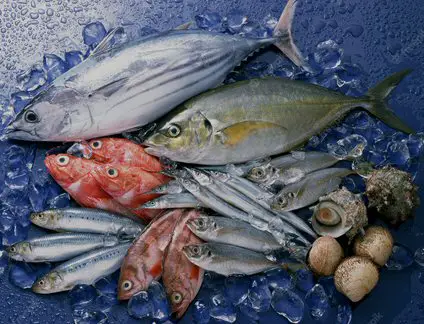
Freshness is crucial when it comes to seafood. The quality and taste of fish heavily rely on its freshness. To ensure you purchase the freshest fish available:
- Buy from reputable fishmongers or seafood markets
- Look for bright, clear eyes and shiny skin
- Gently press the flesh – it should feel firm and bounce back
- Avoid any fish with a strong, unpleasant odor.
Flavour Profiles: Exploring the Depths
Fish offers a diverse array of flavours, allowing you to experiment and create unique dishes that cater to different palates. From mild and delicate to rich and robust, there is a fish to suit every taste preference.
Mild and Delicate Flavours
If you prefer a milder flavour, opt for varieties like:
- Sole
- Tilapia
- Cod
- Halibut
- Mahi-Mahi
Rich and Robust Flavours
For those who enjoy bolder flavours, consider:
- Salmon
- Tuna
- Swordfish
- Sardines
- Mackerel
Versatile and Customizable
Fish is incredibly versatile and can be seasoned, marinated, or cooked in various ways to create unique flavour profiles. Experiment with different herbs, spices, and sauces to enhance the taste of your chosen fish.
Entertaining Options
Seafood is an excellent choice when it comes to entertaining guests. It offers a touch of elegance and sophistication to any occasion. Consider the following options for your next gathering:
- Seafood platter: Include a variety of cooked and raw seafood such as shrimp, oysters, crab legs, and ceviche
- Grilled fish: Fire up the barbecue and prepare whole fish or fillets with a delicious marinade or rub
- Seafood paella: Impress your guests with a traditional Spanish dish that combines seafood, saffron-infused rice, and vibrant flavours.
Vegetarian Alternatives
For vegetarian individuals or those seeking alternatives to fish, there are various seafood substitutes available that mimic the taste and texture of fish. These alternatives are often made from plant-based ingredients like soy or wheat protein and can be used to create delicious vegetarian dishes. Some popular options include:
- Plant-based fish fillets
- Vegan fish sticks
- Fishless seafood soups and salads
Sustainability in Vegetarian Alternatives
When choosing vegetarian seafood alternatives, it is essential to consider their sustainability as well. Look for products that are made from responsibly sourced ingredients and support companies that prioritize eco-friendly practices.
In conclusion, choosing the right fish involves considering factors such as sustainability, freshness, and flavour profiles. Opt for sustainable fish to protect our oceans and ensure their availability for future generations. Explore the diverse flavours available in fish and experiment with different cooking techniques to create delightful dishes. Fish is an excellent choice when entertaining guests and offers numerous options for both non-vegetarian and vegetarian individuals. By making informed choices, you can elevate your culinary skills and create memorable seafood feasts for all to enjoy.
 Two of our good friends from the Isle of Man came to visit us a few days go. This is not Penny or Steve’s first trip to Paris by a long way, so Marie-Danielle and I scratched our heads as to what we could find that would amuse them. Then it came to us… Steve and Penny both like boats and have enjoyed several barge holidays on British canals so what better than to discover a different aspect of Paris in an unusual way, idling down the Canal St Martin through a series of nine locks, two swing bridges, and a 2 mile long tunnel that passes under the Bastille. Problem solved. For 2½ hours, we lazed our way through an almost unknown Paris without a care in the world.
Two of our good friends from the Isle of Man came to visit us a few days go. This is not Penny or Steve’s first trip to Paris by a long way, so Marie-Danielle and I scratched our heads as to what we could find that would amuse them. Then it came to us… Steve and Penny both like boats and have enjoyed several barge holidays on British canals so what better than to discover a different aspect of Paris in an unusual way, idling down the Canal St Martin through a series of nine locks, two swing bridges, and a 2 mile long tunnel that passes under the Bastille. Problem solved. For 2½ hours, we lazed our way through an almost unknown Paris without a care in the world.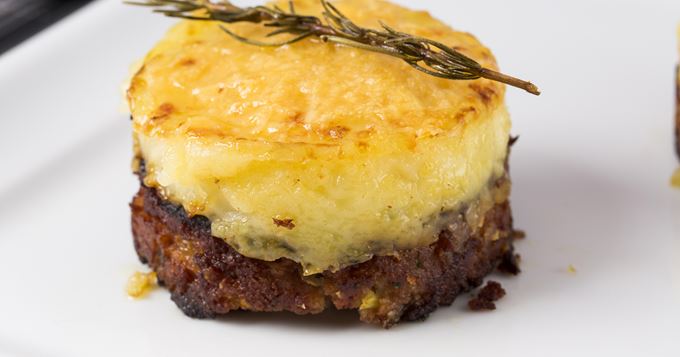 We’ve wined and dined with Steve and Penny on many occasions, so wanted to come up with something a little different. On their arrival on the Sunday, we did a simple Parmentier de Canard (a shepherd’s pie using duck instead of lamb). In fact, this is a bit of a cheat because we use Confit de Canard which we can obtain easily here in France. All I needed to do was drain the fat from the duck, remove the skin, and pull the flesh with a fork. I peeled and chopped some shallots, browned them gently in some of the duck fat, added some chopped parsley and a little seasoning, then covered with mashed potatoes. A bit of oven time and we ate like kings and queens!
We’ve wined and dined with Steve and Penny on many occasions, so wanted to come up with something a little different. On their arrival on the Sunday, we did a simple Parmentier de Canard (a shepherd’s pie using duck instead of lamb). In fact, this is a bit of a cheat because we use Confit de Canard which we can obtain easily here in France. All I needed to do was drain the fat from the duck, remove the skin, and pull the flesh with a fork. I peeled and chopped some shallots, browned them gently in some of the duck fat, added some chopped parsley and a little seasoning, then covered with mashed potatoes. A bit of oven time and we ate like kings and queens!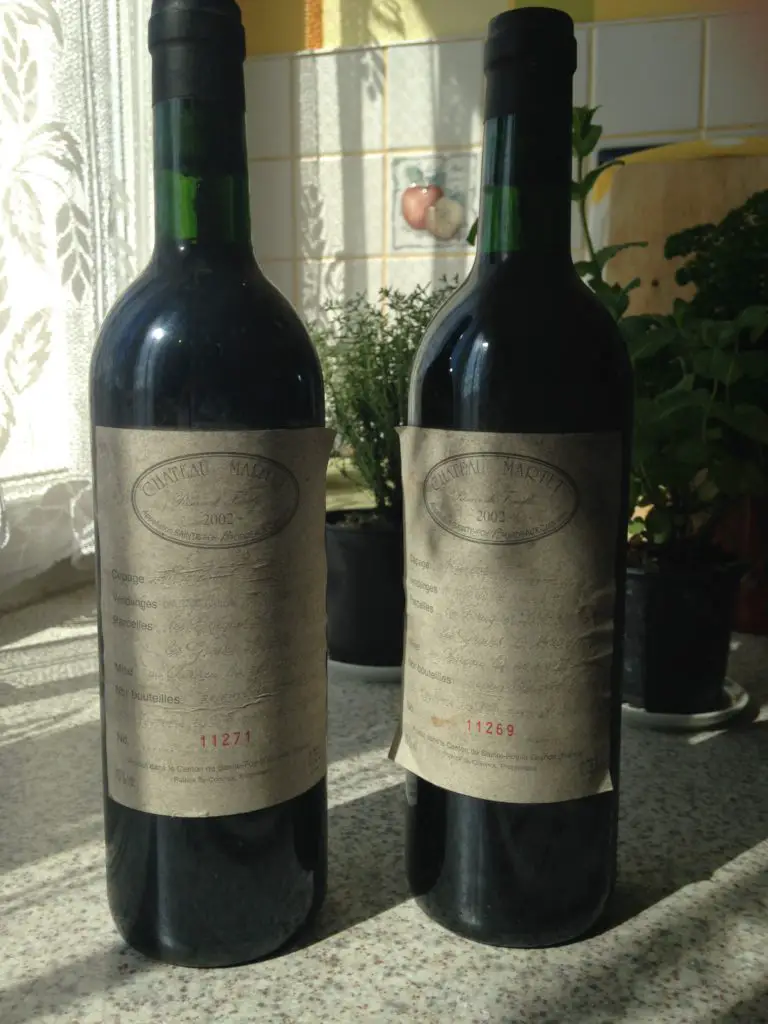 Steve is a big fan of red wine (so are we!) and duck demands a decent full-bodied red. A few weeks ago, we celebrated some family birthdays and discovered half-a-dozen bottles of dusty but interesting-looking 2002 Chateau Martet. The wine was truly wonderful and, since there remained a few more bottles, we grabbed hold of some to go with the Parmentier de Canard. An excellent choice. A marriage made in heaven even!
Steve is a big fan of red wine (so are we!) and duck demands a decent full-bodied red. A few weeks ago, we celebrated some family birthdays and discovered half-a-dozen bottles of dusty but interesting-looking 2002 Chateau Martet. The wine was truly wonderful and, since there remained a few more bottles, we grabbed hold of some to go with the Parmentier de Canard. An excellent choice. A marriage made in heaven even!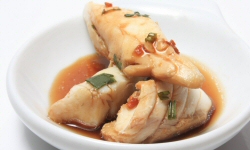 On the Monday, when we had our day out on the Canal St. Martin, we ate in a little restaurant in the Latin Quarter of Paris. Tuesday, we dined at home and I prepared
On the Monday, when we had our day out on the Canal St. Martin, we ate in a little restaurant in the Latin Quarter of Paris. Tuesday, we dined at home and I prepared 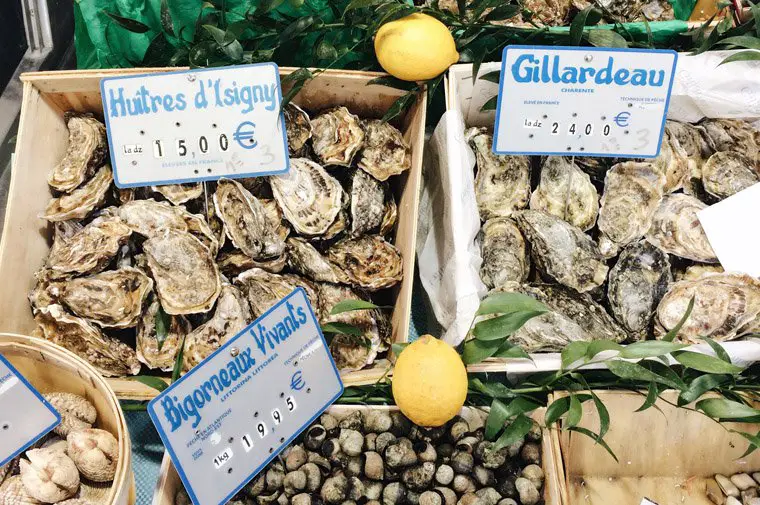 It’s September and there’s an ‘r’ in the months, so the oysters are good. They’ve had all summer to grow and fatten, and now they are truly at their best – fresh and tasting of the sea. Traditionally, in France, oysters are eaten raw and in the shell, freshly delivered from the Atlantic ocean. The best way is to eat them with thin slices of rye bread, salted butter, and lemon juice. Some people add shallot vinegar, and that’s just fine too.
It’s September and there’s an ‘r’ in the months, so the oysters are good. They’ve had all summer to grow and fatten, and now they are truly at their best – fresh and tasting of the sea. Traditionally, in France, oysters are eaten raw and in the shell, freshly delivered from the Atlantic ocean. The best way is to eat them with thin slices of rye bread, salted butter, and lemon juice. Some people add shallot vinegar, and that’s just fine too.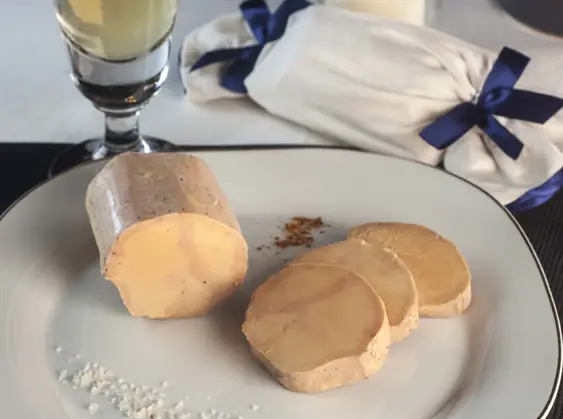 My recommendation is to avoid foie gras altogether if you can’t be sure it has been produced artisanally and ethically. If, however, you get to visit an independent producer on your travels, or have a solid recommendation for one from a chef or discerning cook, buy a terrine de foie gras entier mi-cuit (half-cooked) in a jar and savour every bite. We always buy from
My recommendation is to avoid foie gras altogether if you can’t be sure it has been produced artisanally and ethically. If, however, you get to visit an independent producer on your travels, or have a solid recommendation for one from a chef or discerning cook, buy a terrine de foie gras entier mi-cuit (half-cooked) in a jar and savour every bite. We always buy from 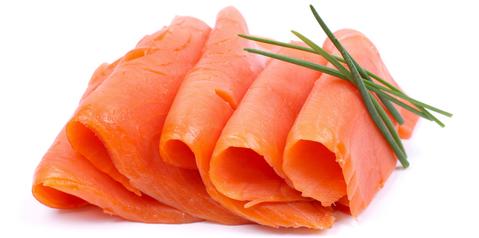 Another luxury food item that has been ruined by the consumer’s insistence to eat it any old day of the year, but no willingness to pay the proper price for it, is smoked salmon. The consequence is factory-farmed salmon that are pumped full of drugs and chemicals to make them grow more quickly. They are destroying the environment, and the result is oily smoked salmon with little firm texture, that just tastes of fish and smoke.
Another luxury food item that has been ruined by the consumer’s insistence to eat it any old day of the year, but no willingness to pay the proper price for it, is smoked salmon. The consequence is factory-farmed salmon that are pumped full of drugs and chemicals to make them grow more quickly. They are destroying the environment, and the result is oily smoked salmon with little firm texture, that just tastes of fish and smoke. Our friends Jill and Bruno are, like us, a French-British couple only the other way round – Jill is British and Bruno is French. They live close to us on the Isle of Man and Bruno is a
Our friends Jill and Bruno are, like us, a French-British couple only the other way round – Jill is British and Bruno is French. They live close to us on the Isle of Man and Bruno is a  Bruno has the same “challenges” and one of the things he misses is that famously French sausage called andouillette. Andouillette is a coarse-grained sausage made with pork intestines (or chitterlings, as we know them in Britain) pepper, wine, onions, and seasonings. True andouillette is shaped like an oblong tube. If made with the small intestine, it is a plump sausage generally about 1″ (2.5cm) in diameter but often it is much larger and stronger in scent when the colon is used. The andouillette has a strong, distinctive odour related to its intestinal origins and component parts. In fact, it is this odour (and subsequent taste) that turns me off this “delicacy”. I have tried eating bits of them several times, but simply do not appreciate them as many in France do. We all have foods like that, which simply don’t “suit” us.
Bruno has the same “challenges” and one of the things he misses is that famously French sausage called andouillette. Andouillette is a coarse-grained sausage made with pork intestines (or chitterlings, as we know them in Britain) pepper, wine, onions, and seasonings. True andouillette is shaped like an oblong tube. If made with the small intestine, it is a plump sausage generally about 1″ (2.5cm) in diameter but often it is much larger and stronger in scent when the colon is used. The andouillette has a strong, distinctive odour related to its intestinal origins and component parts. In fact, it is this odour (and subsequent taste) that turns me off this “delicacy”. I have tried eating bits of them several times, but simply do not appreciate them as many in France do. We all have foods like that, which simply don’t “suit” us.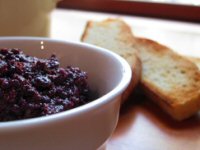 We didn’t do a starter course as such, we simply ‘extended the choices’ of the aperitif. In addition to the usual olives and nibbly biscuits, we provided some slightly more ‘substantial’ fare like quails eggs and toasts with
We didn’t do a starter course as such, we simply ‘extended the choices’ of the aperitif. In addition to the usual olives and nibbly biscuits, we provided some slightly more ‘substantial’ fare like quails eggs and toasts with 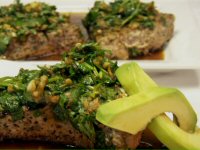 And so to the pièce de résistance, the main course! I believe I’ve mentioned before on this blog that Jill is not vegetarian, but she won’t eat anything that had four legs when it was alive. She’s fine with poultry and fish so I did
And so to the pièce de résistance, the main course! I believe I’ve mentioned before on this blog that Jill is not vegetarian, but she won’t eat anything that had four legs when it was alive. She’s fine with poultry and fish so I did  Last night we hosted a little dinner with some friends who have eaten with us before. It was actually a bit like an unofficial meeting of the conseil syndical de copropriété (the elected committee that help administer the day-to-day running of the apartment buildings). The conseil syndical ensures that lightbulbs are replaced, graffitti is painted over, cleaning is done properly, lifts work, doors and locks are maintained, and other stuff like that. They are elected each year at an AGM of all the owners and last night we had Yvon, Louis and M-D who are already on this committee, Pascale who is putting herself forward for election this year, Louis’ lovely wife, Monique, and of course, myself. So after a short spell on the balcony looking across the whole résidence (photo above), and then an aperitif in comfy chairs, we settled in for some serious eating!
Last night we hosted a little dinner with some friends who have eaten with us before. It was actually a bit like an unofficial meeting of the conseil syndical de copropriété (the elected committee that help administer the day-to-day running of the apartment buildings). The conseil syndical ensures that lightbulbs are replaced, graffitti is painted over, cleaning is done properly, lifts work, doors and locks are maintained, and other stuff like that. They are elected each year at an AGM of all the owners and last night we had Yvon, Louis and M-D who are already on this committee, Pascale who is putting herself forward for election this year, Louis’ lovely wife, Monique, and of course, myself. So after a short spell on the balcony looking across the whole résidence (photo above), and then an aperitif in comfy chairs, we settled in for some serious eating! Starter was nice and simple – foie gras and roulades de Jambon au foie de canard en gelée au sauternes. And if you are wondering what that is, it’s foie gras rolled in ham which we get from
Starter was nice and simple – foie gras and roulades de Jambon au foie de canard en gelée au sauternes. And if you are wondering what that is, it’s foie gras rolled in ham which we get from 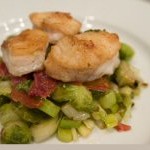 Main course was a repeat of something we have done before (for other people),
Main course was a repeat of something we have done before (for other people),  After a course of cheese and salad, for dessert, we served another of our old favourites,
After a course of cheese and salad, for dessert, we served another of our old favourites,  So to walk it all off, M-D and I went for an afternoon ‘constitutional’ along the river Seine this afternoon. The massive locks there are for the big barges that use the river (some of them up to 100m long) for moving mostly sand and shingle. It’s fascinating watching them manoeuvre into the locks which have a height difference of about 4 metres at this point.
So to walk it all off, M-D and I went for an afternoon ‘constitutional’ along the river Seine this afternoon. The massive locks there are for the big barges that use the river (some of them up to 100m long) for moving mostly sand and shingle. It’s fascinating watching them manoeuvre into the locks which have a height difference of about 4 metres at this point.  While walking, I spotted a brightly-coloured wood nymph! (see left).
While walking, I spotted a brightly-coloured wood nymph! (see left).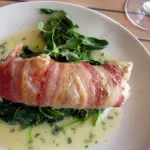 By way of marking our return to France, we invited our friends and neighbours, Terry, Julie, Dominic and Kate to dinner last night. We kicked off in normal style with a glass or two of Kir, using a rather nice Chardonny that had travelled back with us in January. When we settled at the table, we started with
By way of marking our return to France, we invited our friends and neighbours, Terry, Julie, Dominic and Kate to dinner last night. We kicked off in normal style with a glass or two of Kir, using a rather nice Chardonny that had travelled back with us in January. When we settled at the table, we started with 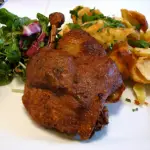 After which, we resorted to one of our regular favourites,
After which, we resorted to one of our regular favourites,  Our dessert was a chocolate and nut gateau that M-D had made using walnuts from her daughter’s garden in The Loire region of France. We served this with orange slices sprinked with orange zest that had been cooked in cinnamon sugar and, just to give a contrast, we mixed normal oranges and blood oranges as we arranged them on the plate. Naturally, there being plenty of chocolate in the cake, we served Mas Amiel with its dense and concentrated inky black Grenache grapes and its complex nose of tobacco and garden herbs.
Our dessert was a chocolate and nut gateau that M-D had made using walnuts from her daughter’s garden in The Loire region of France. We served this with orange slices sprinked with orange zest that had been cooked in cinnamon sugar and, just to give a contrast, we mixed normal oranges and blood oranges as we arranged them on the plate. Naturally, there being plenty of chocolate in the cake, we served Mas Amiel with its dense and concentrated inky black Grenache grapes and its complex nose of tobacco and garden herbs. White wine with Crême de Cassis is known as “Kir” in France and is a popular apéritif drink named after Félix Kir (1876–1968), mayor of Dijon in Burgundy, who popularized the drink by offering it at receptions to visiting delegations. Besides treating his international guests well, he was also promoting two vital economic products of the region – blackcurrants and white wine.
White wine with Crême de Cassis is known as “Kir” in France and is a popular apéritif drink named after Félix Kir (1876–1968), mayor of Dijon in Burgundy, who popularized the drink by offering it at receptions to visiting delegations. Besides treating his international guests well, he was also promoting two vital economic products of the region – blackcurrants and white wine. The main course was the “salty” end of the recipe with
The main course was the “salty” end of the recipe with 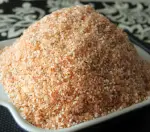 Once the chicken has been treated with the Boursin, you build a complete casing for it using coarse salt, flour, rosemary, thyme, baies, peppercorns and egg whites. It ends up looking like a bomb, but part of the fun of this recipe (and, yes, food should be fun too!) is, prior to serving, showing your guests the cooked “bomb” and seeing if any of them can guess what’s inside. Then, of course, you take it back to the kitchen and remove the salt crust (which takes a certain amount of brute force and muscle!)
Once the chicken has been treated with the Boursin, you build a complete casing for it using coarse salt, flour, rosemary, thyme, baies, peppercorns and egg whites. It ends up looking like a bomb, but part of the fun of this recipe (and, yes, food should be fun too!) is, prior to serving, showing your guests the cooked “bomb” and seeing if any of them can guess what’s inside. Then, of course, you take it back to the kitchen and remove the salt crust (which takes a certain amount of brute force and muscle!) Once you have opened up the crust, you will find (every time without fail) a perfectly cooked golden brown bird, ready to be segmented and served in portions or, very simply, placed on a serving dish and carved at the table. We served ours with mini Brussels sprouts and new potatoes. No need for any sort of sauce or gravy, the moist chicken meat was more than enough – particularly when helped down with a couple of bottles of Domaine du Landetran, L’Ame des Schistes 2010 (well, come on, be fair, there were four of us!).
Once you have opened up the crust, you will find (every time without fail) a perfectly cooked golden brown bird, ready to be segmented and served in portions or, very simply, placed on a serving dish and carved at the table. We served ours with mini Brussels sprouts and new potatoes. No need for any sort of sauce or gravy, the moist chicken meat was more than enough – particularly when helped down with a couple of bottles of Domaine du Landetran, L’Ame des Schistes 2010 (well, come on, be fair, there were four of us!).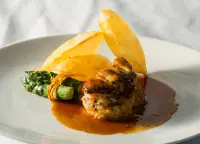 Even eating didn’t stop her talking, though it did slow her down a little as our lunch started with foie gras (as you do!) served with a lovely crisp 2005 Sauternes from Chateau Roumieu. Even M-D’s aunt showed a bit of respectful silence for that one! Following that, we got stuck into the main course of
Even eating didn’t stop her talking, though it did slow her down a little as our lunch started with foie gras (as you do!) served with a lovely crisp 2005 Sauternes from Chateau Roumieu. Even M-D’s aunt showed a bit of respectful silence for that one! Following that, we got stuck into the main course of  At this time of year, Vitelotte Potatoes (also called Vitelotte noire, Négresse or Truffe de Chine) are available in France. Vitelotte is a gourmet variety of blue-violet potato that has been cultivated in France since the early 19th century. In fact, they come in white, yellow, pink, red and violet, but the violet variety are the most common and, though they taste just the same as ordinary spuds, they are fun to use, offering a great alternative presentation on the plate.
At this time of year, Vitelotte Potatoes (also called Vitelotte noire, Négresse or Truffe de Chine) are available in France. Vitelotte is a gourmet variety of blue-violet potato that has been cultivated in France since the early 19th century. In fact, they come in white, yellow, pink, red and violet, but the violet variety are the most common and, though they taste just the same as ordinary spuds, they are fun to use, offering a great alternative presentation on the plate. The main course was served with an excellent Menetou-Salon which, though a red wine, is very light and can easily be served with fish. We skipped the cheese (having filled up on succulent monkfish) but Susanne had brought with her a hand-make chocolate cake from a pâtisserie near Versailles so we did some wilful damage to that, served with a glass or three of Mas Amiel Vintage.
The main course was served with an excellent Menetou-Salon which, though a red wine, is very light and can easily be served with fish. We skipped the cheese (having filled up on succulent monkfish) but Susanne had brought with her a hand-make chocolate cake from a pâtisserie near Versailles so we did some wilful damage to that, served with a glass or three of Mas Amiel Vintage.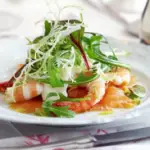 We kicked off with a starter that our neighbours, Julie and Terry, on the Isle of Man had made for us just before we came back to France…
We kicked off with a starter that our neighbours, Julie and Terry, on the Isle of Man had made for us just before we came back to France… 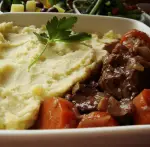 Our main course was
Our main course was  After the cheese, we finished off with M-D’s famous
After the cheese, we finished off with M-D’s famous  Naturally (as you do) we kicked off with a couple of bottles of fine Vranken Champagne Demoiselle Brut Premium Cuvée (it helps wash down the apperitif biscuits and olives!!)
Naturally (as you do) we kicked off with a couple of bottles of fine Vranken Champagne Demoiselle Brut Premium Cuvée (it helps wash down the apperitif biscuits and olives!!)